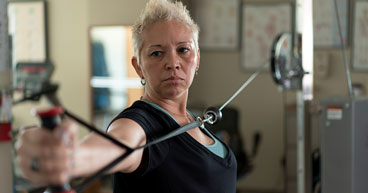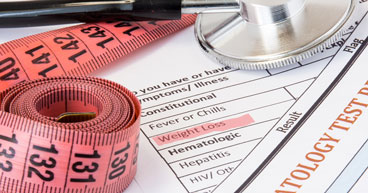
Exercise plays a key role in cancer prevention and recovery. Regular exercise may reduce the risk for developing cancer, help patients with cancer stay strong during treatment and contribute to rebuilding strength and stamina in survivorship.
But that doesn’t mean you have to join a gym, learn how to operate universal weight machines or go to spin class to get the benefits of exercise. Light- to medium-intensity exercise, such as regular brisk walks, is all it takes to significantly reduce the risk for developing cancer and other illnesses, such as heart disease.
An extensive study by the American Cancer Society found that among the exercises that may improve health and reduce disease risk, walking gives the most bang for the buck. The study, involving about 140,000 people, found that even walking at leisurely levels reduces cancer mortality. Study participants, with an average age of 69, said walking was their only form of exercise.
“Going for a walk at an average-to-brisk pace can provide people with a tremendous health benefit. It’s free, easy, and can be done anywhere,” says Alpa Patel, PhD, lead investigator of the ACS study.
For many older people, or those recovering from a serious illness, walking is the best way to start a regular exercise regimen. For those who are physically able, walking requires no training or special equipment other than comfortable shoes. And it offers many of the same health benefits as an intense session at the gym.
“Walking is a perfect exercise for getting your heart rate up, burning calories and boosting your immune system,” says Kirk Bowers, DPT, a physical therapist at City of Hope® Cancer Center Atlanta. “So, there are a lot of benefits to walking and it is easy for most patients to do.”
In this article we’ll explore:
- Walking and cancer risk
- Walking to manage symptoms and side effects
- Getting started with a walking routine
If you’ve been diagnosed with cancer and want to get a second opinion on your diagnosis or treatment options, call us or chat online with a member of our team.
Walking and cancer risk
The benefits of exercise, including taking regular walks, go far beyond reducing cancer risk. Regular exercise strengthens bones, keeps joint lubricated and reduces the risk for developing heart disease.
Many of the other benefits of exercise, not the least of which is controlling weight, are linked directly to a reduced risk for developing many of the most common cancers.
According to the World Cancer Research Fund: “There’s strong evidence that moderate-intensity physical activity (such as brisk walking) as well as vigorous physical activity (including running, fast cycling and aerobics) decreases the risk of colon, post-menopausal breast cancer and womb cancer. There’s also strong evidence that aerobic physical activity, including walking, can help you keep a healthy weight.”
Being obese or overweight is one of the most serious risk factors for developing cancer and it has reached epidemic proportions in the United States. According to the ACS, excess weight contributes to increased risk for developing these cancers:
- Bladder cancer
- Breast cancer
- Colorectal cancer
- Endometrial cancer
- Esophageal cancer
- Head and neck cancer
- Kidney cancer
- Leukemia
- Liver cancer
- Lung cancer
- Myeloma
- Stomach cancer
More than 40 percent of Americans are obese, according to the Centers for Disease Control and Prevention (CDC), raising concerns of future increased incidence of cancer, especially among younger adults.
“We know that the lifetime risk for a number of cancers is very much influenced by weight and obesity,” says Maurie Markman, MD, President of Medicine and Science at City of Hope Atlanta, Chicago and Phoenix. “One can only anticipate a wave of these cancers if we can't attack this problem. We have to figure out a way of dealing with this or we are just going to have cancers that could have been prevented because of this problem of obesity.”
What’s the link?
It’s true that weight loss really starts in the kitchen, not at the gym or on a treadmill. But the combination of eating fewer calories in your daily diet and burning more calories through exercise eventually results in weight loss and better health.
And exercising, including talking regular walks, are linked to other benefits that help manage weight and reduce cancer risk, in the following ways.
Regulating hormones: Exercise may influence the levels of certain hormones, such as estrogen and insulin, which are linked to cancer development.
Supporting the immune system: Regular exercise strengthens the immune system, helping it better detect and attack cancer cells.
Reducing inflammation: Exercise helps reduce systemic inflammation, another cancer risk factor.
Improving digestive health: Exercise accelerates digestion and helps health-promoting gut flora flourish.
“There's emerging data in the cancer world [about] exercise and the net effects, which impacts things like obesity and cellular stress, [so] it's not surprising that there's overlap in those risk factors,” says Stephen Lynch, MD, Vice Chief of Staff at City of Hope® Cancer Center Phoenix.
How much walking reduces cancer risk?
The American Cancer Society (ACS) recommends weekly moderate-intensity activity, which includes a brisk walk, of at least 150 minutes. If you are able to do more vigorous or intense exercises, the ACS recommends 75 minutes a week.
But how much walking you should do doesn’t always align with how much you are able to do.
“There can be a fine line between what your body can and cannot do,” Bowers says. “Sometimes you’ve got to listen to it.”
The bottom line: Do what you can when you can.
Walking to manage symptoms and side effects
For those already diagnosed with cancer, and who are in or have completed treatment, physical activity is often an important ingredient in their recovery.
“A lot of my patients, when they come to physical therapy, they think, ‘Oh, I'm going to be doing this intense exercise. I can't do that. I'm not in shape enough,’” Bowers says. “Light-intensity exercises are more appropriate for older people or for people that have been diagnosed with cancer. If you exercise too intensely, you can cause excessive fatigue or tiredness, muscle soreness. Or even injury. So doing the light-intensity exercise has been shown to be more beneficial for offsetting the side effects of the cancer.”
Walking may be the perfect exercise for those who are in cancer treatment or moving into survivorship. It’s low impact, may be done at any time of day and offers multiple benefits for those with challenging treatment side effects.
The benefits of taking regular walks include:
- Reducing stress, anxiety and depression
- Managing pain
- Building strength
- Increasing appetite
- Improving sleep
- Reducing the risk of a cancer recurrence or secondary cancer
And while it may sound counterintuitive, walking is often a remedy for fatigue, a common cancer treatment side effect. The ACS says that almost all cancer patients report experiencing fatigue beyond what they may consider normal tiredness.
Anthony Perre, MD, FACS, New Patient Intake Physician at City of Hope Atlanta and a Hodgkin lymphoma survivor, says exercise helped him overcome extreme fatigue during and after his cancer treatments.
“Sometimes, you really have to push yourself,” he says. “Look at it this way: Some things you have some control over that can reduce symptoms, and physical activity is one of them.”
Getting started with a walking routine
Starting a walking routine couldn’t be easier. Just lace up the shoes and go. Still, Bowers says, it’s important to start slow and work up to more frequent and longer walks.
“You want to prevent overuse injuries like tendonitis or plantar fasciitis or Achilles tendonitis,” he says. “People may even develop knee pain by ramping up their walking program too quickly. It takes several weeks for your body to get used to an exercise routine. I tell people to start off slowly, maybe a couple times a week up to 30 minutes at a time. Then gradually increase from there.”
What follows are some other tips to help get started on walking routine.
Talk to your doctor: It’s important to consult with your doctor before starting any new exercise regimen. Also, call your doctor if you are feeling ill, lightheaded or having difficult joint pain.
Wear comfortable shoes: Make sure your footwear offers support and doesn’t cause callouses or blisters.
Stay hydrated: It’s important to have some water before, during and after your walk.
Stay fueled: Have a light bite to eat before you walk, especially if you walk before breakfast. “You don't want to get dehydrated or have your blood sugars get too low,” Bowers says.
Stretch: Warm up and stretch your calves, hamstrings and quadriceps to help prevent injury.
Brush aside excuses: A busy schedule or bad weather aren’t good reasons not to take a walk or to exercise, Bowers say.
“Some people have a hard time making a commitment or fitting a 20- or 30-minute walk into their schedule,” Bowers says. “So, I tell people to break it up and do 10 minutes in the morning and 10 minutes in the evening afternoon. And if the weather’s bad, you can go walk up and down stairs or even go to a shopping mall or large grocery stores and walk around there.”
If you’ve been diagnosed with cancer and want to get a second opinion on your diagnosis or treatment options, call us or chat online with a member of our team.



